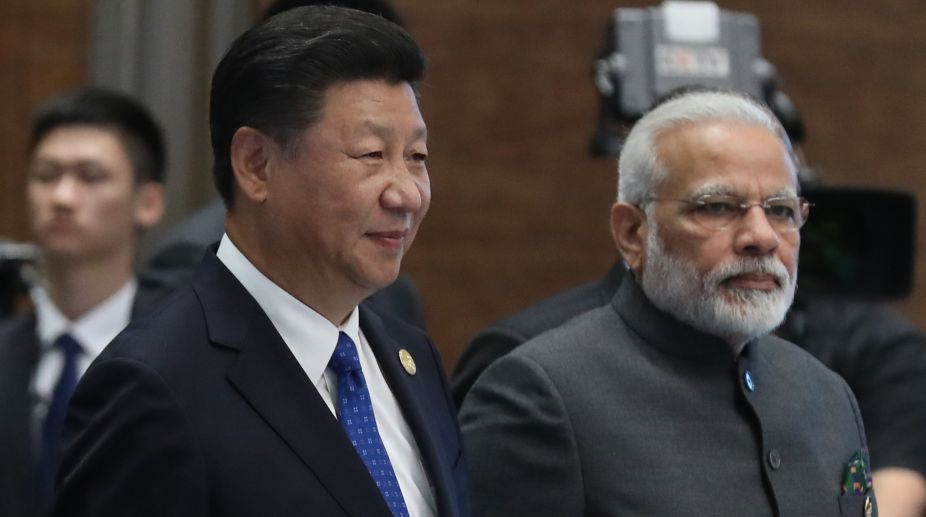Prime Minister Narendra Modi’s recent visit to China to attend the Brazil, Russia, India and China summit in Beijing and then to Myanmar following the 70-day Doklam “standoff” must be reckoned as historic with far-reaching implications.
Firstly, the sustained diplomatic moves by India, notwithstanding jingoistic utterances of Chinese statecontrolled media and even by high officials, enabled both China and India to act as responsible sovereign powers in avoiding an armed conflict. That could have undone all the efforts made in South and South-east Asia over the last four decades towards regional cooperation for peace, stability and economic progress by groupings like the Bay of Bengal Initiative for Multi-Sectoral Technical and Economic Cooperation in South Asia and Bangladesh, Bhutan, India and Nepal.
This demonstration of “responsible sovereignty”, more by India than by China, during the Doklam standoff, sends a message to the sub-region that all differences, not only in matters like “varying perceptions about the boundaries” can be resolved within the framework of an agreed “rulesbased order” by a process of give-andtake, because an armed conflict in today’s technology-led warfare entails unacceptable costs for both the contending powers. A Sino-Indian conflict could only benefit Pakistan to the disadvantage of both China and India as it would enhance that country’s bargaining power with China and even the US and capacity to create more trouble in Kashmir.
The Doklam disengagement thus shows that there is truth in Dr Henry Kissinger’s dictum that “successful diplomacy is generally more about managing problems than solving them outright”.
Second, the Doklam stand-off established, once again, the vulnerability of the “Siliguri corridor”, North Bengal and rail-road link to the Northeast to any build-up of military infrastructure and offensive capabilities of the Chinese in the India- BhutanChina tri-junction. Strategic moves are always made on the “capabilities” perceived as real threats while intentions can change. Therefore, in a scenario of Chinese build-up, threat perceptions will be more if the internal security situation worsens as it has in parts of the region bordering Tibet for decades which, to put it bluntly, have been to the advantages of India’s adversaries without, in any way, raising the prospect of the ethnic groups involved in the “unrest” and “insurgencies” for a better future.
Rather, these movements only provided opportunity for narrowlybased political classes for undue gains. However, thanks to a longstanding national commitment to assist the North-east states to overcome the development lags and sustained efforts of the people of the region, it has been able to achieve six per cent plus growth during the 11th and 12th Plan periods.
And, this growth momentum should continue as the North-east states have been provided with Rs 3,13,375 crore under the 14th Finance Commission award. This is a huge amount and will go up further by direct central investment and expenditure under central sector projects of the railways, civil aviation, national highway authority and central support to state schemes. The Central funding presents a real challenge before the North-east as it has been designed to enable the region to “leap frog” to allround progress.
In the shadow of Doklam, a similar approach and a special development package are urgently required for North Bengal and North Bihar districts, bordering Nepal and Bhutan, because from a strategic angle these areas fall within the “extended part of the North-east” following the inclusion of Sikkim in the North Eastern Council.
However, to realise the development potential, the diverse ethnic groups of this region have to accept and cultivate what is articulated the world over, as the concept of “responsible self- determination”, much like the practical idea of “responsible sovereignty” grounded in the reality of interconnected geo-economics.
Otherwise, the pursuit of selfdetermination, even in forms such as demand for full statehood of several ethnic groups of North Bengal and the North-east, will only raise the cost of administration and irretrievably erode the prospect of a vibrant regional economy, capable of joining the Association of South-East Asian Nations and sub-regional initiatives like the BIMSTEC.
In fact, the North-east has been suffering from annual “growth loss” of roughly 1.5 to 2 per cent, even in periods of reasonable growth, due to the “identity politics” of statehood demands and the disorder associated with the same, which holds good for the Darjeeling hills and North Bengal as well.
There are strong geo-political and geo-economic reasons to reject identity politics by the ethnic groups pursuing this line in their own interest, which may be summed up as the “China factor” arising out of the rapid growth of the Chinese provinces bordering India such as Schezwan and Yunnan .
This has, first created a large market and fuelled huge demands for energy, which drove China to construct a gas and oil pipeline from the Yangon coast of Myanmar to Ruili, a border town of Yunnan to feed the industries of South China. In the present rapidly globalising order, Chinese economic clout, already evident in Myanmar, is bound to affect the North-east in many unforeseen ways.
To meet this challenge, what is needed is an integrated development and security strategy for the subHimalayan region, covering North Bihar, North Bengal, the North- east, Bhutan and East Nepal, which could be put through as a sub-regional initiative under the Bangladesh, Bhutan, India and Nepal forum.
This is to ensure that the projected Chinese investments in infrastructure in Nepal and Bangladesh under the Belt and Road Initiative, are dovetailed to projects like the Trans-Asian Railway and Highway network to accelerate growth and diversification of the North-east’s regional economy and building integration in the process.
To develop this strategy, a separate economic survey of the extended North-east is essential. This is not there in the Centre’s annual economic survey, as in the last two years, the survey was primarily devoted to macroeconomic issues like creating a single market, assessment of trade intensity and didn’t address regional imbalance or geo-strategic economic issues for peace, stability and growth of strifetorn border regions.
In a prescient article entitled “China and the world” published in the January- February 2017 of Foreign Affairs, a reputed American journal, Evan A Feigenbaum argued that “China is a disruptive power and not a revolutionary one” and “the size of her economy is still 61per cent of the US economy.”
China also suffers from a serious mismatch between her capitalist economy and the one party dominated political system. This fact creates a perpetual feeling of insecurity in the minds of the leaders promoting China to build up tension in the neighbourhood, often to satisfy her domestic constituencies and her “uneasiness” about Tibet, seen from her practice of issuing stapled visas to Indian citizens from Arunachal Pradesh and covert support to some North-east insurgents.
Nevertheless, the Doklam disengagement possibly suggests that enhanced economic interaction might as well be a kind of insurance, if not deterrence, to rash action by either party on the border issue. Thus, to be an active participant in this power game, which is critical for its future, the extended North-east needs an integrated development and security strategy to engage with Tibet, Nepal, Myanmar, South China, Bangladesh and the rest of the ASEAN.
The writer is a retired IAS officer of the Assam-Meghalaya cadre and has served as a scientific consultant in the office of the principal scientific advisor to the government of India










